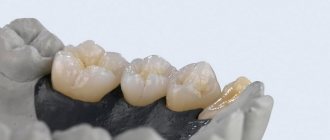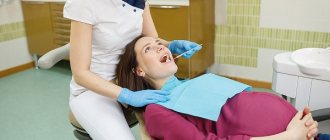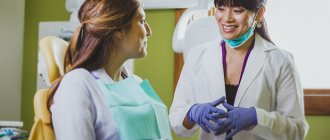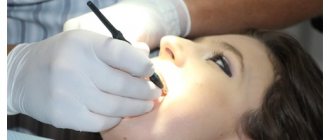Expecting a baby is one of the most wonderful periods in a woman’s life. Her thoughts are focused on dreams of the future baby and joyful worries about children's things, a stroller, and toys. But changes in the body sometimes prepare unpleasant surprises for the expectant mother. Thus, many women feel dryness, itching and burning in the intimate area during pregnancy. What caused them?
Why does itching and burning occur in the intimate area during pregnancy?
While expecting a baby, a woman’s hormonal background is completely restructured, as a result the vaginal microflora changes, which leads to the appearance of pathogenic bacteria and fungi that cause discomfort. If you add to this the wearing of synthetic underwear, the use of sanitary pads with fragrances, and too hot weather, then unpleasant symptoms such as dryness, burning and itching in the intimate area may appear during pregnancy. Many women are ready to sacrifice good health for the health of their baby. Fearing taking medications, they endure discomfort until the birth. However, itching, pain and burning during pregnancy force the expectant mother to be in a state of constant stress, which only increases the discomfort. If you feel discomfort in the intimate area, consult a doctor who will tell you what is causing it and help you choose the right treatment.
Chlorhexidine Pharmland, solution for external use 0.5 mg/ml
In patients with open traumatic brain injury, spinal cord injuries, or perforation of the eardrum, contact with the surface of the brain, meninges, and the cavity of the inner ear should be avoided.
In case of contact with the mucous membranes of the eyes, they should be quickly and thoroughly rinsed with water.
Contact of hypochlorite bleaches on fabrics that have previously been in contact with chlorhexidine-containing medications may cause brown stains.
Use Chlorhexidine Pharmland with caution in conditions where the systemic effect may be dangerous, especially in children, if the skin is damaged over large areas.
Special precautions. Given the lack of information on transdermal absorption, systemic effects cannot be ruled out. The likelihood of their occurrence increases with repeated applications, especially when a large area is treated, the surface under an occlusive dressing or mucous membranes, in the presence of damage to the skin (in particular burns), as well as in the case of treating the skin of newborns (taking into account the ratio of the surface area and body weight of the child and occlusive effect of diapers).
The use of chlorhexidine solution in newborns as a skin antiseptic before invasive procedures is associated with a certain risk of developing a chemical burn. Based on spontaneous reporting and literature data, a higher risk of skin reactions has been identified in preterm neonates, particularly those born before 32 weeks of gestation, in whom chlorhexidine was used during the first two weeks of life.
Before performing invasive procedures, it is necessary to remove all materials soaked in chlorhexidine: bandages, sheets, napkins, gowns, etc. Do not use excessive amounts of solution. The solution should not be allowed to accumulate in skin folds, under the patient’s body, or on materials that are in direct contact with the child’s skin.
If an airtight dressing (occlusive dressing) is to be applied to skin that has previously been exposed to chlorhexidine, ensure that there is no excess chlorhexidine solution on the skin before applying the dressing.
After opening the polymer container, there is a risk of microbial contamination of the drug.
What diseases of the intimate area can occur during pregnancy?
Often, during pregnancy, the expectant mother is bothered by irritating discharge with an unpleasant odor, itching, and dryness. The cause may be one of the following infections:
- thrush.
Its appearance is caused by the proliferation of yeast fungi on the mucous membrane of the intimate area. The infection can be transmitted to the child during childbirth, affecting the mucous membranes of the mouth and genitals; - bacterial vaginosis.
Caused by pathogenic bacteria and manifests itself in the form of gray discharge with an unpleasant odor; - urinary tract infections
. Hostile microorganisms penetrate the urinary organs when urinating from the intimate area. Cutting and burning are the first signs of this condition. This does not harm the baby, but can lead to kidney inflammation, which is dangerous for the expectant mother.
If you see a doctor in time and undergo the necessary treatment, you can avoid dangerous complications.
What else can you use to rinse your nose?
In no case - only an isotonic solution. Everything that we add additionally, either garlic juice or some herbal decoctions, are allergens of plant origin. And we can cause or provoke an allergic reaction.
Another thing is some kind of antiseptics, then yes. Antiseptics that can be added to the rinsing solution - for example, elemental Chlorhexidine or Miramistin. These drugs can even be diluted one to one.
But this is when we talk about bacterial rhinitis. And in our case, acute viral rhinitis occurs against the background of ARVI. But then, in the event of some unfavorable factors, let’s say a decrease in immune status, some kind of air pollution, a secondary bacterial infection very often occurs. And gradually viral rhinitis (viral infection) is replaced by a bacterial form.
Filmed specifically for the educational project “Dispensary” profilaktorium.ru
Tips for intimate hygiene for an expectant mother
Burning and itching in the intimate area during pregnancy can be prevented. Here are 6 simple tips to help reduce your risk of developing infections:
- Take a shower no more than 2 times a day. Water and soap remove natural protection - beneficial microbes.
- Choose intimate hygiene gels containing lactic acid or plant extracts: linden, chamomile, blue lotus, white tea. These natural components have a positive effect on the condition of the most delicate area of our body.
- Dry your body thoroughly after intimate toilet with a cotton towel. Do not share a towel with other family members.
- Wear panties made of 100% cotton, which help your skin breathe and do not create a greenhouse effect, especially in hot weather.
- Use pads filled with cotton extract. They allow oxygen to pass through well, which destroys yeast.
- Replace the bath with a shower. Hot, soapy water can bring dirt into the body and wash away beneficial bacteria. If you really want to soak in the bath, wash yourself in the shower first. Use sea salt instead of foam.
How to rinse your nose?
To alleviate the condition, it is necessary to clean the nasal cavity. This is rinsing the nasal cavity with an isotonic solution. It can be prepared at home.
“For a liter of warm boiled water, a teaspoon of table salt.”
For rinsing at home, you can use a 20 gram syringe. The most important thing is that when we introduce liquid into the nasal cavity while blowing your nose as you exhale, do not cover the blowing side of the nasal cavity. That is, do not increase the pressure in the nasal cavity.
When you blow your nose incorrectly, there is a high chance of infection getting through the auditory tube into the middle ear area and otitis media occurs.
Through the anastomosis from the nasal cavity, an infection can enter the paranasal sinuses and sinusitis occurs - this is, first of all, sinusitis and frontal sinusitis.
What you need for the rinsing procedure
To rinse your nose correctly, you need to prepare certain devices. Everything you need is freely available on pharmacy counters.
For processing, you will need a syringe without a needle (5 ml is enough) or a syringe bulb (no more than 50 ml). It is convenient to use Chlorhexidine solution with a special “neti pot” washing device made of ceramic or plastic. The choice of equipment depends on preference.
Chlorhexidine is collected in a container and rinsing begins. It is advisable to do this in the bathroom, or above the basin. The person leans forward 45 degrees, his head is turned slightly to the side. Mouth breathing is smooth and constant. The contents of the container are slowly poured into one nostril. With the correct position of the body, the liquid will pass through the nasal passage and pour out through the second nostril or mouth. There should be no discomfort, burning or itching. Daily rinsing of the sinuses helps to quickly get rid of the infection. Eliminates runny nose, improves overall health.
—>
Pediatricians do not recommend clearing the nose of infants with antiseptic. Young children have narrow airways. Under high pressure, Chlorhexidine can get into the child’s ears, thereby triggering the development of otitis media. In this case, self-medication is completely contraindicated. Any actions must be agreed with the attending physician, and therapy is carried out only under the supervision of a specialist.
- How to gargle with Chlorhexidine for adults, children and pregnant women?
Children over 6 years old wash their noses like adults. To prepare the child physically and psychologically, doctors recommend that parents show the procedure by example.
Indications
You should use chlorhexidine for washing in the following cases:
- inflammatory processes in the vagina (colpitis, vulvitis, candidiasis, cervicitis);
- sexually transmitted diseases (trichomoniasis, bacterial vaginosis, chlamydia, syphilis, herpes, ureaplasmosis, gonorrhea, vaginitis and others)
- treatment of genitals before examination;
- sanitation of the tract before childbirth;
- treatment of postpartum injuries and wounds;
- during casual sexual relationships;
- damage and erosion of the cervix;
- before inserting an intrauterine device;
- before taking biological samples for research;
- before artificial termination of pregnancy;
- if it is not possible to cleanse the intimate organs;
- with an inflammatory process in the urinary tract (urethritis).
The human body cannot be protected from HIV (immunodeficiency virus) and PSV (papilloma virus).
Methods of application
Therapeutic washing with chlorhexidine is performed for both therapeutic and prophylactic purposes. You should wash your face for five minutes in the morning and before bed, remembering to dry your genitals well with a towel. This technique is possible even for pregnant women, since the medicine is not directly injected into the vagina, and it is not absorbed into the blood vessels and deep into the muscles of the organs, thereby minimizing harm to the fetus. The same applies to the lactation period.
How to use the medicine for certain diseases? If at a consultation a gynecologist or urologist made a diagnosis and prescribed treatment with this drug, then you should follow the individual prescribed doses of the required concentration. This depends on the severity of the pathology, in conjunction with the presence of complications and the severity of symptoms.
Washing the internal mucous membranes with a medicinal preparation in women is called douching, and in men it is called lavage (of the urethra). This can be done both in a hospital under the guidance of medical staff, and independently at home.
To prevent illness after unprotected intimacy, you need to visit the toilet within the first few hours, wash your hands, rinse your genitals, and then inject two milliliters of chlorhexidine into the urethra by douching for a couple of minutes. After this, it is advisable not to go to the toilet for several hours. This simple measure will help both women and men protect themselves from numerous sexually transmitted diseases.
The ideal solution for mucous membranes is 0.05%. It can be obtained by diluting 0.5% chlorhexidine with boiled water in a ratio of 1:10.
Chlorhexidine is used for intimate hygiene according to the following method:
- The syringe is disinfected and the drug is poured into it.
- A woman lies horizontally in a bathtub or on a couch with a prepared medical blanket or on a bed with oilcloth and a diaper.
- Approximately 10 ml of the product is applied to the inflamed surface of the organ.
- The drug should remain inside for three minutes.
- There is no need to rinse the vaginal cavity with water. It is better to wait for spontaneous flow or push it out with internal muscles. And to avoid any mishaps, you can use a gasket.
If during insertion of the tube or the influence of the solution is felt, it is advisable to interrupt the procedure.
Methods of use in the treatment of certain diseases:
- For urethritis, the drug is used as part of a complex treatment. 2-3 ml of a 0.05% aqueous solution of chlorhexidine is injected into the urethra once or twice a day. The procedures are carried out every other day for no more than 10 days.
- For vaginal candidiasis, douching with chlorhexidine also cannot be the only treatment for the disease, but in combination with other drugs it gives a good result and allows you to remove external symptoms. Irrigation of the vagina and external organs is performed with a low concentration solution. Before starting the procedure, the liquid must be slightly warmed to room temperature. Then pour it into a syringe. The spout should be inserted deep into the vagina and the procedure should be carried out slowly. It is important not to release liquid from the syringe under pressure, as this can lead to its penetration into the uterus and the development of serious inflammatory processes inside it.
The solution cannot be heated due to changes in the chemical properties of the drug and the reduction of pharmacological properties.
For treatment to be effective, you should adhere to the following rules:
- Do not use cosmetics for intimate hygiene.
- Do not take medications with iodine.
- Do not mix with other antiseptics.
- Both sexual partners should undergo the course of treatment.
- Follow your doctor's instructions.
- Carry out procedures regularly and thoroughly.
Treatment with chlorhexidine does not guarantee complete cure in one go, but it is effective and safe.
Benefits and harms
Chlorhexidine is a universal broad-spectrum antiseptic. The benefits of its use are associated with the effective fight against:
- infections,
- growth of pathogenic microflora,
- bacteria,
- fungi,
- inflammations,
- some strains of viruses.
If you use an antiseptic according to the instructions, there is virtually no harm. It can only cause harm if used for a long time without consulting a doctor. This is due to the fact that it kills not only pathogenic but also beneficial bacteria. This creates the possibility of candidiasis or dysbacteriosis. It is also possible for the microflora to develop resistance to antibiotics and lead to narrowing of the urethra and impaired urination.
Side effects
This medication has virtually no side effects. Only rarely can the following occur:
- Allergic reactions in the form of hives, rashes and swelling;
- Chemical burn of the mucous membrane (with continuous use);
- Dry mucous membranes (with increased treatment time);
- Vaginal bleeding in the presence of mucosal defects.
The occurrence of side effects should be the reason for discontinuing the drug and consulting with your doctor.
Contraindications
You must be careful when using an antiseptic, because this is not an easy water and an unusual antiseptic spray, and it has a number of the following contraindications:
- children under 12 years of age;
- dermatitis;
- dry skin;
- individual sensitivity.
You cannot use it daily for washing. It is also worth noting that during critical days, use is not advisable due to a decrease in the therapeutic value of the drug. And before going to the doctor, you should not douche, as this will complicate the correct diagnosis.
Hygiene rules for a pregnant woman
As a rule, pregnancy is accompanied by such features as increased sweating, increased vaginal discharge, and frequent urination. All this increases the possibility of infection. Therefore, one of the main recommendations for hygiene during pregnancy is to carry out hygiene procedures more often than usual.
Take a shower or bath more often
In addition to the hygienic effect, a shower also gives a boost of energy, lifts your spirits, improves the health and overall tone of you and your unborn baby. But when taking a shower, you should not allow the jet pressure to be very strong. If you decide to take a bath, make sure that the water is not too hot. You can't overheat.
Important! Be sure to buy a small rubber bath mat with suction cups. It should be placed under your feet to avoid falling while showering. After all, on a slippery surface there is always a risk of slipping.
Visiting a bathhouse during pregnancy
You should not visit the bathhouse in the early stages of pregnancy (up to two months). This increases the risk of improper formation of the placenta, and, as a result, fetal pathology. Also, you should not start visiting a bathhouse during pregnancy if you have never done this before. Pregnant women who have any complications or threats of miscarriage should also not visit the sauna. In other cases, on the contrary, visiting a bathhouse during pregnancy will help to harden and prepare for childbirth. In addition to removing toxins and deep cleansing the skin, the bath has a positive effect on the circulatory system: it increases the elasticity of ligaments, cleanses the pores of the skin, and also makes it more elastic, relieves tension from the muscles, and also prevents the occurrence of stretch marks.
Important! While in the bathhouse, maintain good hygiene to avoid infections. In the steam room, sit or lie down only on a clean towel. Don’t overload your body: don’t sit in the steam room for too long, and don’t douse yourself with ice water afterwards.
Oral hygiene
Brush your teeth at least twice a day, or better yet, more often. And don't forget to change your toothbrush once every three months. Toothpaste and brush must be of high quality. Don't skimp on them. Try to always brush your teeth or at least rinse your mouth after eating sweets.
Important! If you were unable to cure all your teeth and put your mouth in order before conceiving a child, then when you go to the doctor, be sure to warn him about your pregnancy.
Taking care of your body
During pregnancy, you should pay attention to the fact that shower products and body care creams have a neutral PH factor and contain moisturizing components, and also do not have a strong odor. If your regular body care products meet these requirements, then there is no need to change them during pregnancy.
Important! For depilation, it is better to use a razor rather than chemical creams. Use an epilator only if you used it regularly before pregnancy, and your skin has long been accustomed to this procedure, which is sometimes quite painful in the early stages.
Taking care of your hair
As a rule, during pregnancy, due to changes in hormonal levels, hair becomes incredibly thick, beautiful, strong and practically does not fall out. But despite this, during pregnancy, especially in the first trimester, it is not recommended to perm or dye your hair. If you decide to dye your hair, do it with natural dyes - henna, basma and others. It also happens less often that hair problems during this period, on the contrary, worsen:
- If your hair has become very oily, try not to wash it with too hot water: it further increases the secretion of the sebaceous glands. Use herbal decoctions of nettle, chamomile, coltsfoot for rinsing. You can also make kefir masks - before washing your hair, apply a kefir mask to your hair for half an hour.
- If your hair has become very dry, try to apply various nourishing oil masks to your hair before each wash. On the contrary, it is recommended to wash such hair with very warm water.
Tanning in the sun and solarium
We strictly recommend abstaining from both the first and second during pregnancy.
Due to hormonal changes, the body of pregnant women begins to produce much more skin pigment - melanin - than usual. For this reason, a woman’s complexion often changes. For the same reason, if you overdo it with tanning, age spots may appear on the body.
Self-tanning is also not the best solution, since it contains chemical components that easily penetrate through the skin and into the blood and placenta, having far from the best effect on the development of the baby.
Important! If you decide to soak up the sun with your belly open, do it out of direct sunlight (for example, in a little shade) and in short sessions to prevent your stomach from overheating.











